Samsung Galaxy S 6 and S 6 Edge: Preview
by Joshua Ho on March 26, 2015 9:00 AM EST- Posted in
- Smartphones
- Samsung
- Mobile
- Galaxy S6
- Galaxy S6 Edge
GPU Performance
As previously discussed, on the GPU Samsung has added two additional shader cores to the Mali T760 for additional performance in addition to a clock speed bump from 700 to 772 MHz maximum. To evaluate the effects of this we look at GFXBench which is generally accepted as a pure GPU benchmark.

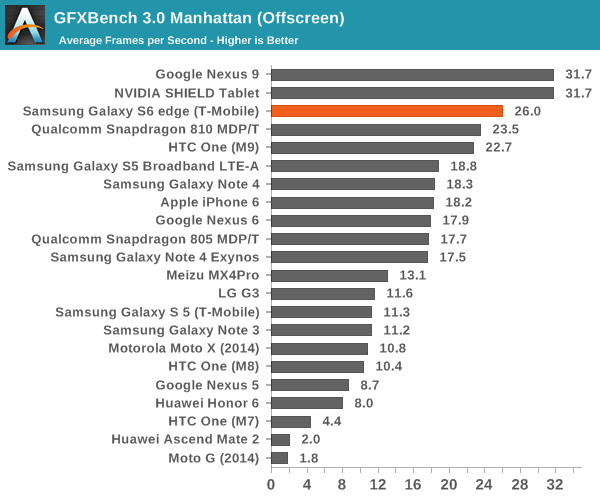
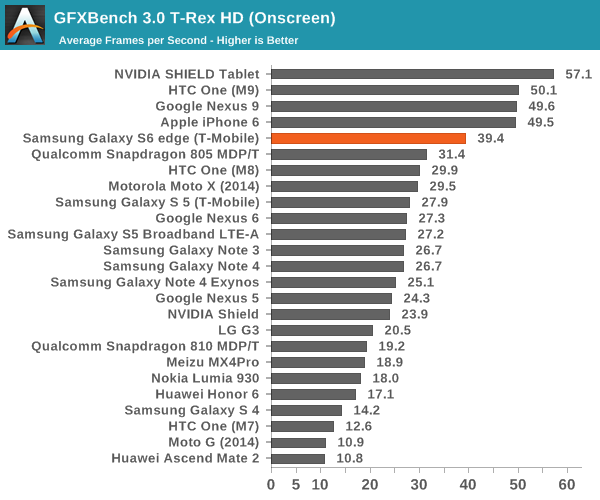
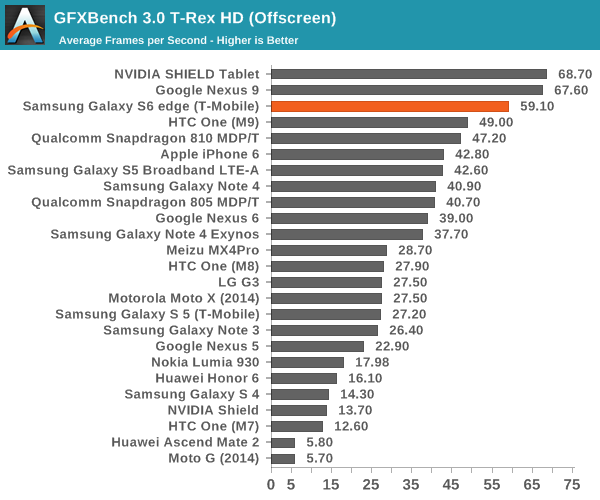
From the results the Mali T760MP8 GPU of the Exynos 7420 performs admirably in comparison to the Adreno 430 of the Snapdragon 810. We see a 10% lead over the Adreno 430 in Manhattan, growing to 20% in T-Rex. Qualcomm hinted that the Adreno 430 is more strongly improved in ALU performance over the Adreno 420, which would explain why the gap isn't as significant this generation. A 700 MHz clock on the Adreno 430 would likely equal to T760 in this case, but I suspect the power consumption of such a clock would be untenable. The Galaxy S6 does fall behind on the on-screen benchmarks due to the 1440p display compared to the 1080p display of the One M9, but rendering at a lower resolution would avoid most of these problems in real games.
Display
As previously discussed, the Galaxy S6 line introduces a newer generation of AMOLED displays, which is said to increase maximum luminance to 600 nits. Samsung claims that this was achieved with the use of new materials, which is likely necessary in order to sustain power efficiency improvements. It doesn't seem that AMOLED is uniquely suited to high resolution, but rather that Samsung Display Corp. is managing to dramatically improve how they make AMOLED displays with every year that offset power consumption increases from higher resolution displays. To find out how Samsung did, we use SpectraCal's CalMAN 5 Ultimate, in addition to X-Rite's i1Pro2 Basic to characterize displays as accurately as possible.
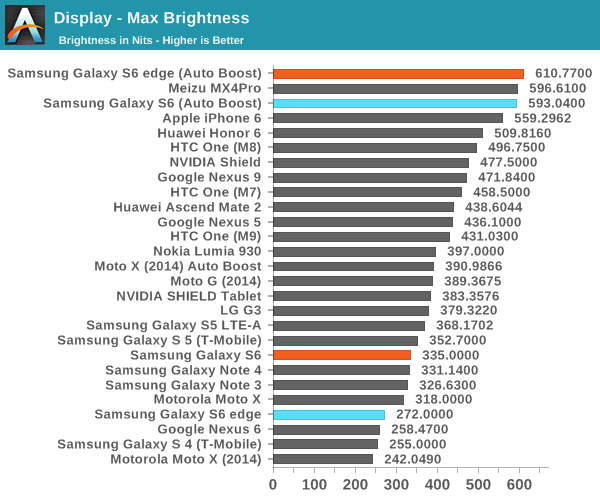
From the results Samsung's claims of a 600 nit display are valid in this case, which is a 100% APL white display. It's important to note that achieving this requires the use of auto-brightness, and that manual brightness is limited to a much lower brightness to reduce power usage, here the S6 sees similar maximum brightness as the S5. The S6 edge disappointingly only achieves 272 nits in this mode, a rather low value. I saw color balance shift dramatically in auto-boost mode, which suggests that this operating mode is likely less efficient than manual brightness. As an explanation, we've seen that colors are controlled in AMOLED by voltage while brightness is controlled by PWM (pulse width modulation). As with most recent AMOLED displays, there's no DC bias to the pixels so the contrast really is infinite instead of just a very large number when displaying black.
Galaxy S6
Galaxy S6 edge
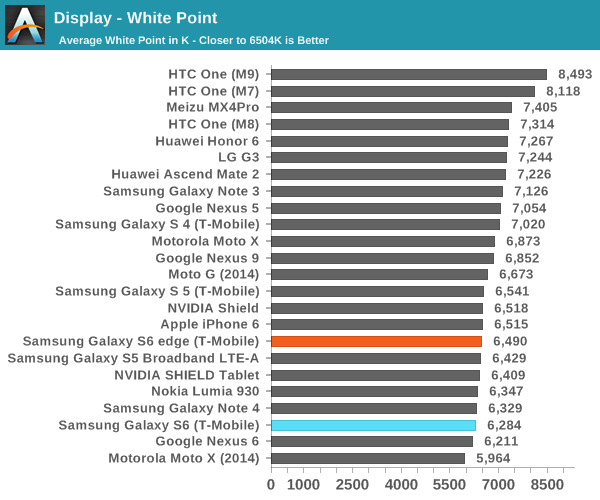
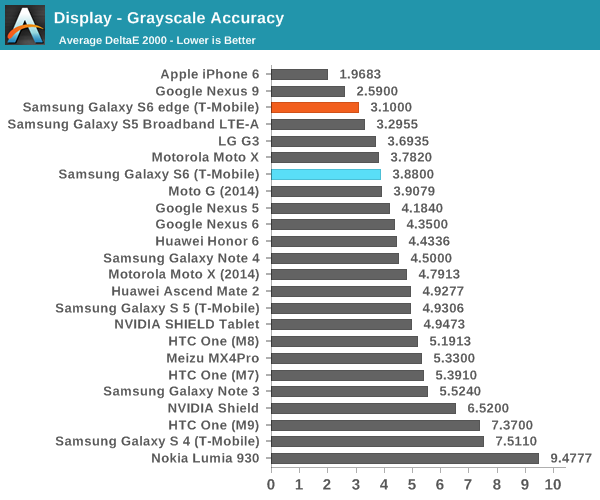
Moving on to grayscale, we can see that Samsung has done a pretty good job of controlling the white point and gamma across the saturation sweep, even if green is slightly dominant in both displays. We can also see that there is variation across displays as the S6 edge is closer to neutral while the S6 sample tends a bit warmer.
Galaxy S6
Galaxy S6 Edge
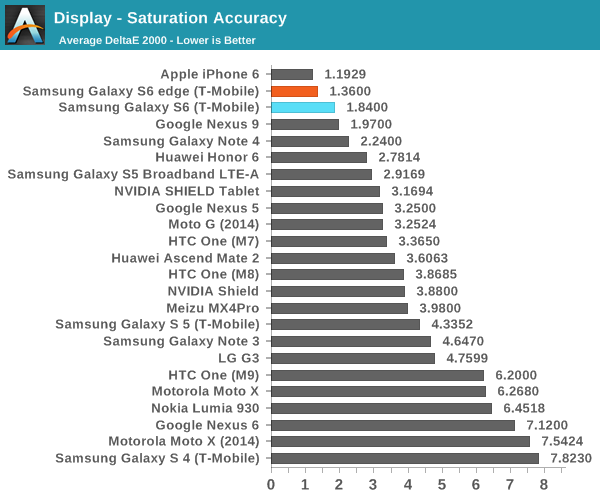
In the saturation sweep, both displays do an incredible job. I really don't have anything else to say here, because there's really no way to improve on the level of calibration Samsung has done on this display. Unless Samsung calibrates every single display in production, which is wildly impractical and effectively impossible to do, this is as good as it gets for a mass-produced device. Improving past this point will also be incredibly difficult to perceive, which means there's no real reason to go any further.
Galaxy S6
Galaxy S6 edge
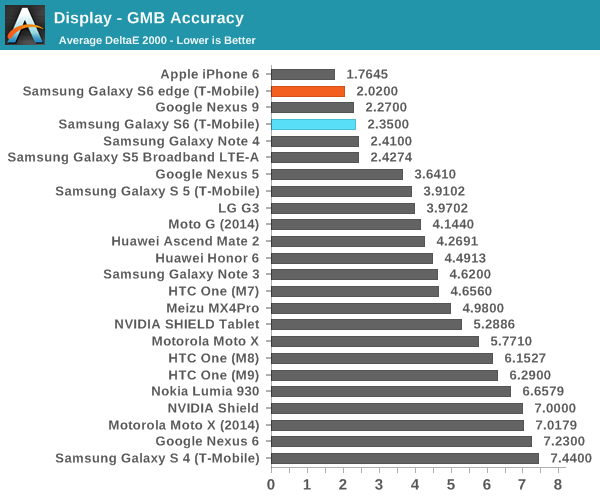
In the Gretag MacBeth ColorChecker, we can get an idea for overall color accuracy, which paints a picture similar to the saturation test. The only real problem I've noticed with these displays are the viewing angles, which can produce color shifting when the display is tilted. This is a bit of an issue on the edge variant as I can see that the edges of the display appear somewhat green when viewed head on, but otherwise there are no real issues to be seen here. Overall, this is probably the best display anyone will be able to get in a smartphone right now. This level of progress is amazing from Samsung, given just how bad things were with the Galaxy S' AMOLED display, even as recent as the display of the Galaxy S4. With the Galaxy S5 review, I said that I wouldn't be surprised to see AMOLED equal, if not exceed LCD within a year or two, and Samsung has managed to finally hit that mark.



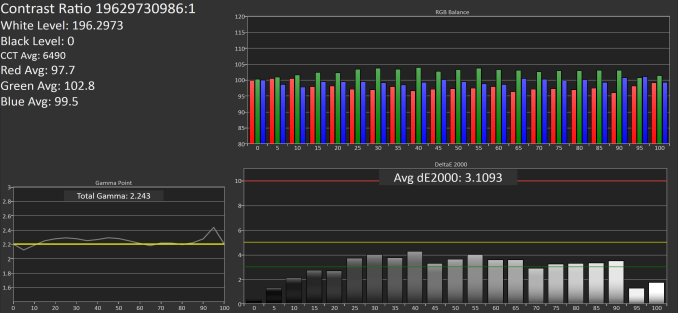
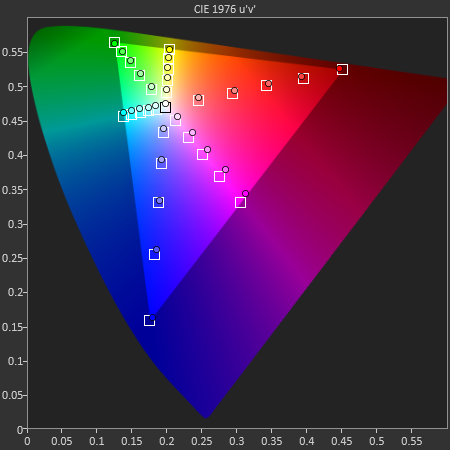
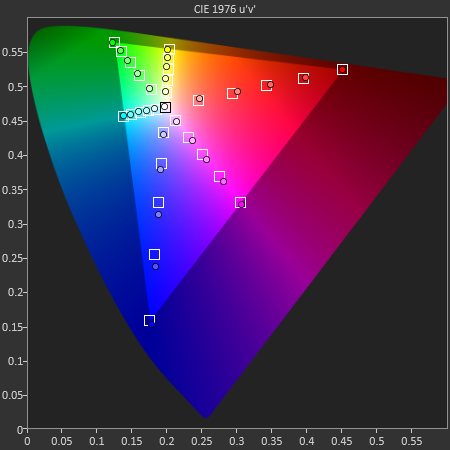
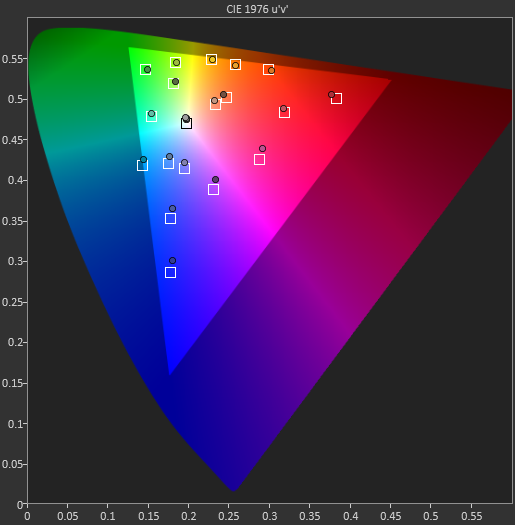









200 Comments
View All Comments
steven75 - Friday, March 27, 2015 - link
Apple Pay uses NFC too. ;)Most of the world is already on chip and PIN and the US is moving to that this year. Magnetic strips is targeting the past.
hrrmph - Friday, March 27, 2015 - link
"...They decided to rip off the iPhone 6 in both design and features..."Exactly. Samsung had a superior functionality product - even it it was wrapped in high-quality plastic. Now they have downgraded themselves to making an iPhone.
Just like Apple, Samsung is now killing off functionality. All in a quest to make jewelry instead of computing machines.
Instead of getting 128GB hardwired and 200GB expandable = 328GB storage (plus future upgrades beyond 512GB) we are stuck at 32, 64, or 128... just like iPhone.
Instead of being able to justify buying at the high-end of the market and then keeping a device in great condition for the long-term by occasionally popping in a fresh new battery, we are stuck tossing the device away... or sending it off to a hack shop for a dodgy "service center" battery replacement... just like an iPhone.
Samsung is being unusually quiet about how many and which LTE bands they will support. So I'm guessing that out of the 44 LTE bands available worldwide, Samsung is in no position to give us a world-phone that will work on every continent... just like an iPhone...
(but watch out next year though when Apple implements the new 29 LTE band Intel modem chip that *should* be enough to cover all bands currently in use on all continents)
So let's face it... Samsung shat themselves here. There is no long term investment to be made in an S6. Samsung has downgraded us to buying an iPhone knock-off.
And the iPhone is gradually improving. Maybe in another generation or two, the iPhone could surpass the S5 Duos in functionality. Apple only needs to add a removable battery, a Micro-SD slot, and a 2nd SIM slot.
With Samsung hellbent on making iPhones, the only upgrade path from the Galaxy S4 now *IS* to the Galaxy S5. Forget the S6.
ama3654 - Thursday, March 26, 2015 - link
Please use Stock browsers next time, OEM's don't have optimization on chrome. Or use chrome for iOS devices as well. ThanksAzurael - Thursday, March 26, 2015 - link
Stock browsers give another venue for OEMs to cheat, not the best idea... And Chrome has hamstrung Javascript performance on iOS, so no good there. You'll have to live with it!Drumsticks - Thursday, March 26, 2015 - link
So far the S6 seems to have come through with everything we figured it would.Better performance than the 810, Great display, better materials. To me, The MicroSD and the removable battery aren't huge, but I AM worried about the smaller battery size overall. Battery will be the most important test for this device, so we'll have to see just how well it does. Presumably, it could make or break it just like the Camera (in a way) makes or breaks the One M9.
If I can get a solid day and then some (to handle battery decaying later on to get a full day in a year), with the rapid charge and all that it all brings, I think I'll be happy. Samsung Pay as well seems pretty interesting.
Overall, Android has gotten interesting enough to make me think about coming back. I had a Lumia for the last two years and was actually perfectly happy with it, but I like bouncing back and forth between Android and WP. I've used an iPhone 5 the last 3 months or so because of switching to AT&T (928 doesn't work there), but I haven't been very impressed. At this point, I'm just waiting on some reviews of the S6 that I trust (namely Anandtech and Ars), and possibly waiting to see what the G4 has to bring to the table. Unfortunately, unless something huge changes, I think I'm skipping the One M9; there are just too many side steps to consider to me.
Shadowmaster625 - Thursday, March 26, 2015 - link
I do not understand. For what purpose or for what app is a 1080p display not adequate? Even if using multi-window multitasking, is it really that important? Multi-window multitasking will drain a battery twice as fast, so do you really want the added drain of such a ridiculous display?darkich - Thursday, March 26, 2015 - link
Well, Samsung’s virtual reality headset is the only good reason I can think oflilmoe - Thursday, March 26, 2015 - link
I really wished they stuck with 1080p... But Samsung is a business; they're trying to compete in the spec sheet AND they're trying to create a new market with VR.At least give the non-resolution-happy crowd like me an option to lower the res back to 720p (1:1 vs 1440p). 8-12 subpixels per pixel would be nice on that display (and the Note 4's).
SydneyBlue120d - Thursday, March 26, 2015 - link
In the final review I ask You to dig as deep as possible about the Samsung (or Intel?) modem used especially against HTC One M9 (e.g. take a look at this article http://goo.gl/TwDMkm ), audio quality and HEVC encoding/decoding support (if it will be added in the future or if the SOC doesn't support it). Thanks a lot.Andrei Frumusanu - Thursday, March 26, 2015 - link
The SoC has HEVC encoder and decoders but Samsung again doesn't expose it to the OS.